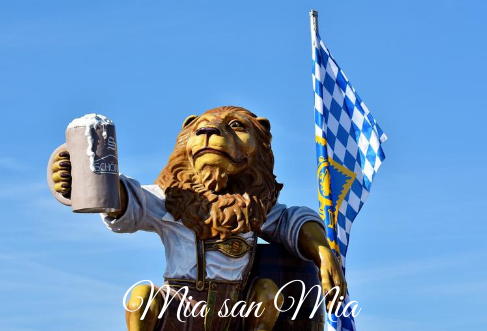Augsburg is an independent city in southwest Bavaria and is one of its three metropolises . The Metropolis and Regional Center tiers were introduced in February 2018. Metropolises only exist in Bavaria .
Augsburg is the fifth oldest city in Germany (Kempten, Mainz, Trier, Neuss and Augsburg) and the third largest city in Bavaria after Munich and Nuremberg. The number of inhabitants in Augsburg has now grown to almost 300,000 people , around 45,000 of whom live in the city centre . Also noteworthy is the number of around 20,000 students who attend the university, which was founded in 1970 and is networked worldwide.
Aha! Cool ...
Emergence of Augsburg
The city belonged to the Roman Empire for more than 400 years . During the transition from Roman times to the Middle Ages , Augsburg became a bishopric . The 13th century brought Augsburg imperial immediacy , i.e. direct subordination to the emperor , before 500 years later the city fell to Bavaria under Napoleon .
In the 15th and 16th centuries , Augsburg reached its peak due to the long-distance trade, banking and metal business of the Fuggers and Welsers . From the 18th century, the textile industry developed and from it mechanical engineering . Rudolf Diesel built the diesel engine here. Linde invented the refrigeration machine in Augsburg and Messerschmitt produced the first serial jet aircraft here.
Industrialization began early in Augsburg with the textile industry. Mechanical engineering and electrical engineering developed from it. Augsburg has been the center of the Bavarian mechatronics cluster since 2006 . Car wash systems were not only invented here, but also manufactured here (Wesumat – Kleindienst – Washtec).
The Fuggers
Augsburg became 15 BC. Founded as a Roman colony more than 2000 years ago . In time it became a trading center between Italy and Central Europe , reaching as far as Turkey . Augsburg is famous for being home to the Fugger family, one of the wealthiest families in history .
An economic empire that, with a bit of gold and a lot more silver , but above all with copper, lead and mercury , rose to become the dominant metal company in Europe and, quite incidentally, also made a legendary fortune with tin and iron . Weaving, pepper trading and banking with emperors, kings and popes were only part of the truth.
With the exploitation of ore mines and with smelting works in seven countries - Austria as well as Italy, Slovakia, the Czech Republic, Poland and Spain as well as Germany - Jakob Fugger became legendary rich . The smelting centers produced products made from the alloys of bronze, brass and gunmetal, making the Fugger the “ Krups of modern times” so to speak.
Unbelievable
Waterworks is now a UNESCO World Heritage Site
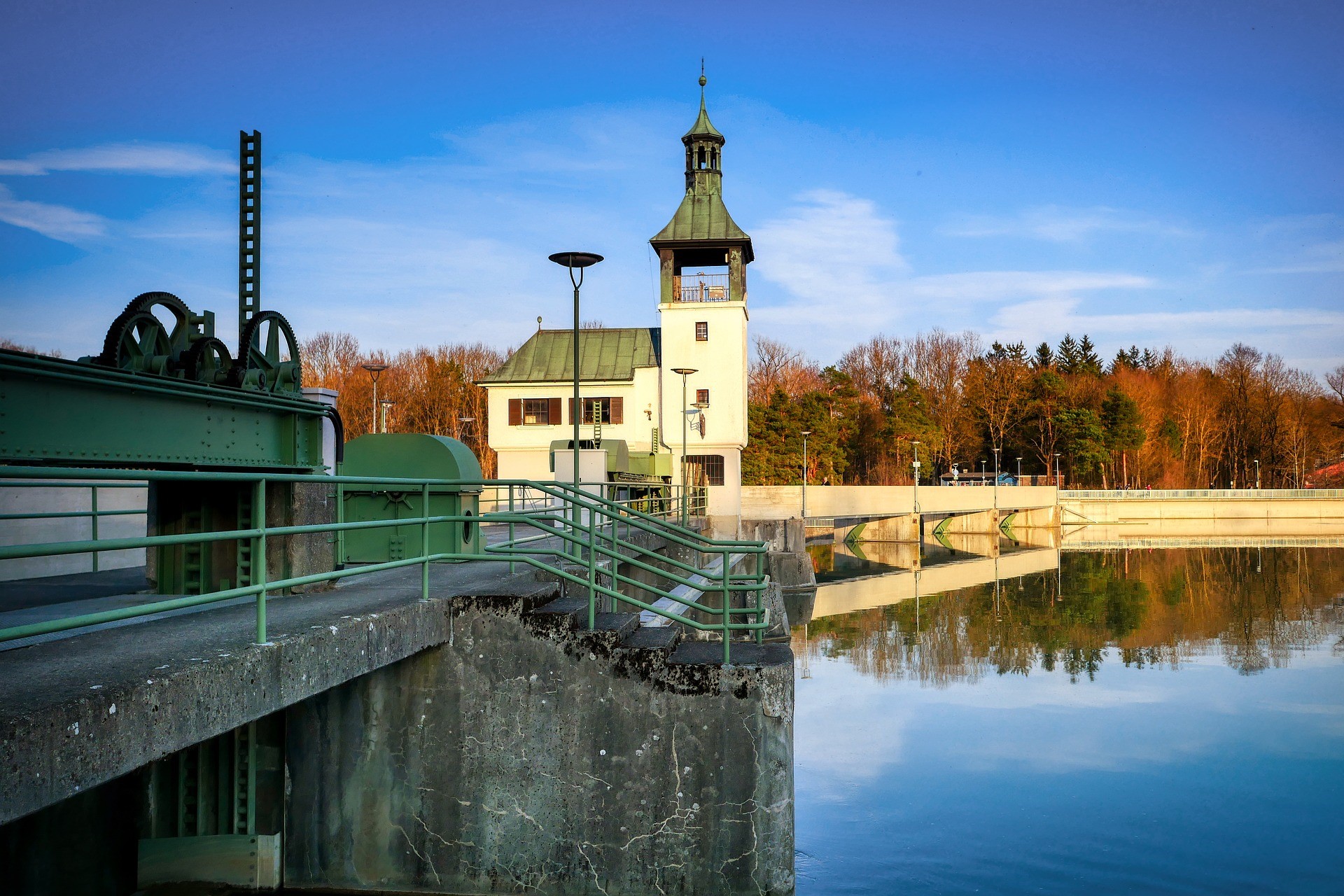
Waterworks Augsburg
The unique building is a central part of today's UNESCO World Heritage , which has been recognized since 2019. Today's waterworks at the Hochablass is a unique combination of architecture and originally preserved water technology from the 19th century. As a monument, the waterworks is reminiscent of a facility that supplied drinking water in a metropolitan city for almost 100 years and in which you can still feel the splendor of the industrial age today.
With wise foresight and the clever use of modern technology , the groundwater flow in the city forest was tapped at this point, right in the middle of the “ kingdom of good water ”, so to speak. Not an easy task, but such a great challenge for the engineers at the Augsburg machine factory , whose systems and boilers are still considered a technical masterpiece to this day.
Pumping water using water power and without a water tower was a technical marvel when this waterworks at the Hochablass was built. It was called a temple of technology . The water pumps in the building are still in good condition. From 1879 they pressed about 4 million cubic meters of water into the Augsburg pipeline network.
The Fuggerei
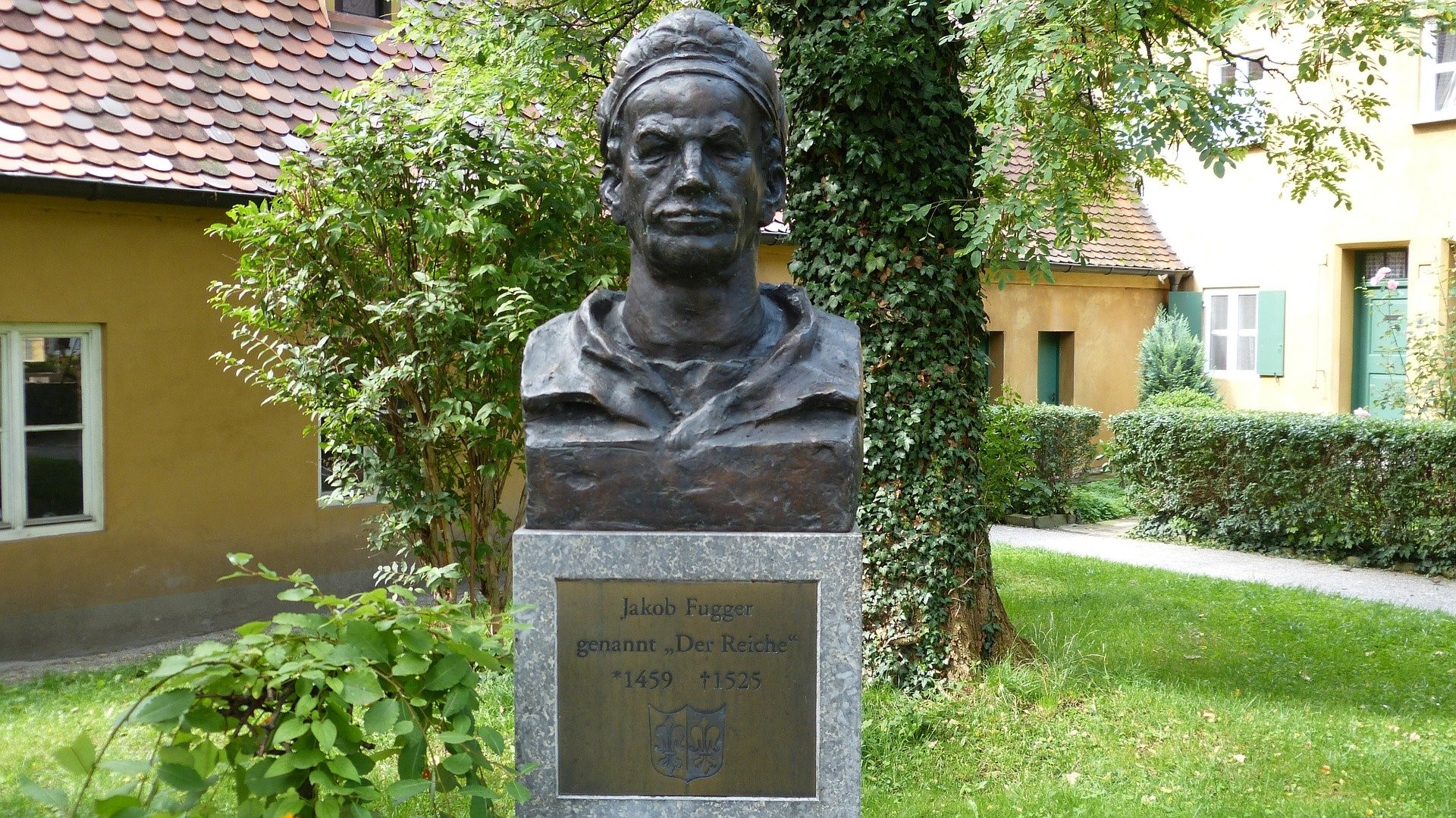
Fugger of the rich
The Fuggerei in Augsburg is the oldest existing social settlement in the world . This row house settlement with its impressive 15,000 square meters was built almost 500 years ago by Jakob Fugger the Rich, also in the name of his deceased brothers Georg and Ulrich, for needy Augsburgers and has continuously fulfilled its foundation purpose ever since .
No alms, but help for self-help . Housing should only be given to those in need who were trying to earn an income , e.g. B. to poverty-threatening craftsmen and day laborers with or without families. This guaranteed one's own home, and needy citizens were not forced to beg or live in visible poverty.
The foundation of the Fuggerei thus corresponded to the self-image of a society for which the common good took precedence over self-interest . Even today, 150 needy Catholic Augsburg citizens live in the 140 apartments of the 67 houses for an annual rent of 0.88 euros and three prayers a day.
The demands on the Fuggerei as a residential and living environment kept changing, and the structure was adapted accordingly. In the middle of the 17th century z. For example, a school was set up for a while to educate children according to Catholic beliefs . There were buildings of other foundations and foundation purposes and even a clergyman.
Even in more recent times, the Fuggerei's infrastructure has been adapted to the circumstances - for example with the construction of its own bunker during the Second World War, which today houses an exhibition as a bunker museum. After the war, a widow's building was built between Neue Gasse and Gartengasse especially for surviving wives, as well as a widow's building on Markusplatzle.
What is there to see?
The town hall
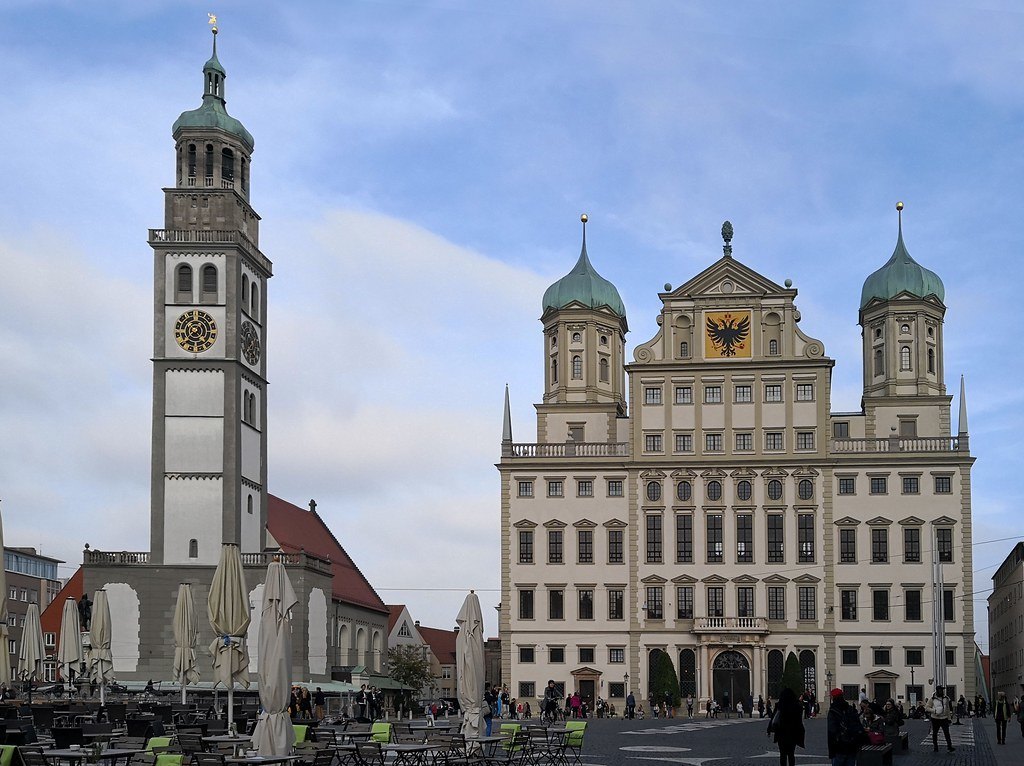
Town Hall Augsburg right and Perlach Tower left Source: Flickr
The Augsburg town hall is considered one of the most important secular buildings of the Renaissance north of the Alps and is one of the most impressive town halls in Germany . Elias Holl built the Augsburg town hall in the late Renaissance. Between 1615 and 1620 the exterior work was completed. The interior work ended in 1624 .
At that time, Augsburg was an important financial and commercial city with pride and self-confidence. The self-image of the imperial city of Augsburg is expressed in two conspicuous ornaments on the huge gable on the front of the town hall: the painted imperial eagle symbolizes the imperial immediacy of the city, the large copper one Pine nut about the awareness of your own importance.
The town hall is particularly famous for the Golden Hall . Located on the second floor of the Augsburg town hall, the Golden Hall covers an area of 552 m² with a ceiling height of 14 meters . With its impressive portals, the lavish wall paintings and last but not least the magnificent coffered ceiling, it was already considered the highlight of artistic interior design at the time of its creation.
When City Hall was built, it was the first building in the world to have more than six stories . Even today it is a landmark of Augsburg that impresses every tourist.
The Augsburg town hall is Elias Holl's masterpiece and is one of the most art-historically valuable town halls in the world. But because it was destroyed in World War II , it is mostly a copy. That is why it is not included in the World Heritage List by Unesco . Due to its historical importance, it is subject to the Hague Convention for the Protection of Cultural Property in the Event of Armed Conflict.
Perlachturm
At 70 meters , the Perlach Tower is one of the tallest buildings in Augsburg . In 989 it was built as a watchtower . At that time it was not even half as high as it is today. Over the centuries it has undergone numerous transformations. In 1526 it was increased to 63 meters.
Shortly thereafter, the tower received clockwork with a bell . When master builder Elias Holl rebuilt the town hall, he also put his hand to the Perlach Tower. From 1612 to 1618 it got its current appearance with the columned dome , the onion roof and the figure of the Suebian city goddess Cisa .
- War: During the Second World War , the Perlach Tower was equipped with anti-aircraft guns. During the night bombing raids by the British Royal Air Force on 25/26. In February 1944, the entire upper tower floor burned down, but the tower was able to be reopened in 1950 after renovation work.
- Turamichele : In the days around September 29, Michaelistag , the Turamichele (Tower Michel), a mechanical puppet show about the Archangel Michael , appears at the bottom window of the Perlach Tower. Children in particular gather on this day on the town hall square and count out loud when the mechanical angel stabs the devil lying at his feet every hour on the hour to the beat of the chimes. On the weekend closest to September 29th, there will be a big children's festival on the town hall square.
- View: You have to climb 258 steps to be able to look out over the old town of Augsburg from the Perlach Tower. 200 to 300 guests make the ascent to a height of more than 70 meters per day and receive a "Certificate of Ascent " as a souvenir.
Augustusbrunnen
The Augustus Fountain is the oldest of Augsburg's three magnificent fountains and has the most figures and is located on the town hall square . The fountain is dominated by a figure of Augustus, which is 2.5 meters high and weighs 27 hundredweight.
A marble pedestal rises above a quadrangular, bulbous marble basin with semicircular bulges, on which rises the crowning bronze figure of Emperor Augustus
The Augustus fountain is a water management monument that communicates hydraulic engineering, economic and technical, legal and perhaps even religious aspects from the period up to 1588. Together with the town hall and the new building from 1 614, it emphasizes the high status of the imperial city.
Herkulesbrunnen

Hercules Fountain Augsburg
The Fountain depicts the Greek hero Hercules fighting the Hydra, the serpentine monster of Greek mythology that has nine heads and grows two new heads when it loses a head .
The model of all heroes is shown: the muscular, naked Hercules, who wears a victor's armband in his hair . In his hand he carries a club from which flames erupt . With it he tries to kill the seven-headed, scaled and winged monster , the Hydra.
According to Greek legend , Hercules used the mace of flame to singe the roots of the severed heads and thus prevent the Hydra from putting forth new ones. The victory of man over the wild power of water and the power of fire is represented in this way.
Hercules is depicted on the fountain pillar as a hero of virtue who has decided against vice, depicted in the mythological-allegorical imagery as an instinctive lust : Hercules only overcame vice through his virtue. In the end, the mortal Hercules was rewarded with immortality for his virtuous actions.
Schaetzler Palace

Schaetzlerpalais Augsburg
The Schaezlerpalais was built in 1765-70 by order of the banker Benedikt Adam Liebert von Liebertshofen . As a palace in the city of banks at Augsburg's street number 1, Maximilianstrasse , only the best was good enough . The impressive two - storey ballroom is the heart and at the same time the highlight of the palace .
The Austrian resonates in this room, which Gregorio Guglielmi decorated with a ceiling fresco. Immediately before that he had been employed at Schönbrunn Palace .
The garden in the Schaezlerpalais has become a very special place to relax . In addition, the garden is now accessible to everyone and has become a very special place to relax for many Augsburg residents and tourists.
Since the spring of 2013, the former henhouse of the Schaezlerpalais has had new residents: a bee colony with up to 60,000 bees in summer has moved into the upper floor and now produces plenty of honey during the warm season.
The builder's great-grandson, Dr. Wolfgang Freiherr von Schaezler and his wife donated the building to the city of Augsburg in 1958 with the stipulation that it would never be sold and only used for cultural purposes . A wise decision, because there is hardly any other place where architecture and content harmonize so perfectly.
House of St. Mary
The Augsburg Cathedral (also: Hoher Dom Mariä Heimsuchung ) is the cathedral of the diocese of Augsburg . The origins of the cathedral are dated to the 8th century . The core of today's complex was built in 995 . Foundations from the 4th century were excavated under the Romanesque-Gothic cathedral (1978/79), which may indicate an early Christian church and a bishopric.

House of St. Maria, Augsburg
The two bell towers of the High Cathedral can be seen from large parts of downtown Augsburg. At 62 meters high , they are among the tallest buildings in the historic old town of Augsburg, along with the Basilica of St. Ulrich and Afra and the Perlach Tower . The cathedral is 113.25 m long and the nave is 38.70 m wide . The height of the central nave is 17.80 m and that of the presbytery of the east chancel is 28 m .
During repair work on the north tower tip in May 2018, the tower ball was removed from the top and opened . Documents from the years 1598, 1848 and 1952 , which had been left behind in the sphere during construction work in the respective years, came to light.
- There are two large organs in the Augsburg Cathedral: the Marie organ and the Magnificat organ. The Marie organ was built in 1904 by the organ builder Franz Borgias Maerz . The Magnificat organ was built in 1988 by the organ builder Rudolf Kubak (Augsburg).
Bells: In the south tower of the cathedral there is a six-part bell . Two beehive bells (so-called Theophilus bells ) hang in the north tower. Both bells only sound on special occasions and are rung by hand . These two historic bells are also known as "silver bells" - with a view to the fact that they were also rung to receive the canons ' attendance fees.
Cloister : The late-Gothic cloister was created from 1470 through a conversion of the older predecessor structure, the southern wing of which had already been integrated into the nave of the cathedral as an outer side nave in the 14th century .
Cathedral nativity scene: One of the oldest nativity scenes in Germany is located in the ambulatory. It was probably made around 1580 by the Augsburg sculptor Paulus Mair. There is a commemorative plaque to the left of the crib. It is reminiscent of the former Augsburg cathedral canon Christoph von Schmid . Among other things, the Christmas carol “ Your little children, come ” goes back to him.
The weaver house

Weberhaus, Augsburg Source: Pinterest
The Weberhaus is one of the oldest buildings in the city of Augsburg . It was originally a large late-Gothic building that was rebuilt several times and brightly painted . The facade design of the Weberhaus is an important example of the painting of buildings with iconographic and allegorical themes from the history of a city and is therefore of great urban significance.
The size of the house should reflect the importance of the weavers' guild for Augsburg . This is where the master weavers met. Around 1600 almost every fifth Augsburger was a weaver . Before the Thirty Years' War, Augsburg was one of the most important textile production sites in Europe and had more than 2,000 weavers' workshops .
The hidden lady's court
The most famous court in Germany , which still radiates the splendor of the Renaissance in Augsburg with its Italian-style columns; artistically the most important inner courtyard of the Fugger houses .
The northernmost of these courtyards was reserved for the Fugger women and therefore offers an exclusive atmosphere . This is where the name of the Damenhof goes back to for this Fugger inner courtyard. Here everything breathes Italy - due to the building styles of the Renaissance . A pool of water in the middle of the courtyard creates a relaxed atmosphere , and the surrounding arcades provide sun protection in summer .
The Damenhof is the highlight of the entire complex of Fugger houses and a " hortus conclusus ", a closed garden. The Damenhof is reached via a side door in the Mittelhof. (Address: Maximilianstr. 36)
The Botanical Garden
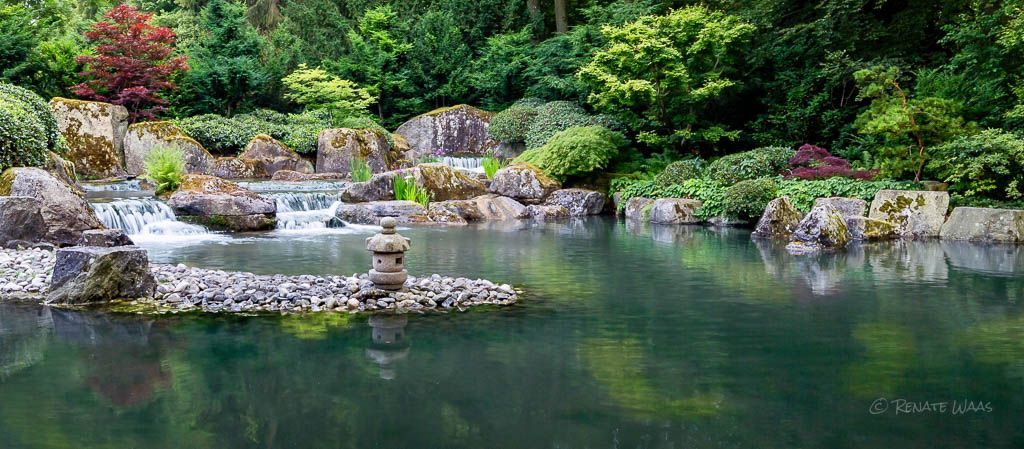
Botanical Garden, Augsburg
The botanical garden celebrated its 80th birthday in 2016. Natural idyll and oasis of peace. Over 3,000 species of plants bloom and green in the Botanical Gardens in Augsburg – spread over various themed gardens. Whether in the Roman, farmer, apothecary or water garden, everyone will find their personal favorite spot . As a " silent" star , the Japanese garden promises peace and harmony .
In general, information events and practical seminars are held in spring, with seasonal themes following in summer and autumn. Between the end of January and Easter is usually the butterfly exhibition and the concerts , serenades and services have their time in the summer. The jazz summer of the botanical garden from July to August deserves special mention here. Special illumination evenings take place in the warm season from June to August.
Parking garage Annahof (recommended starting point)
Im Annahof 4
86150 Augsburg
